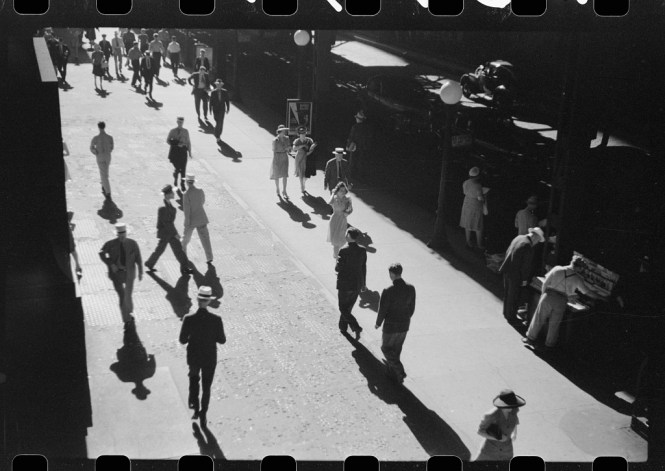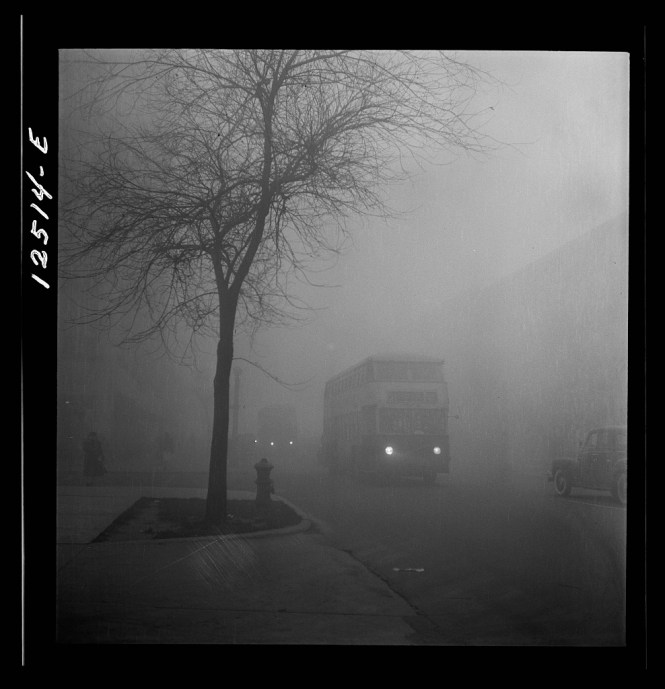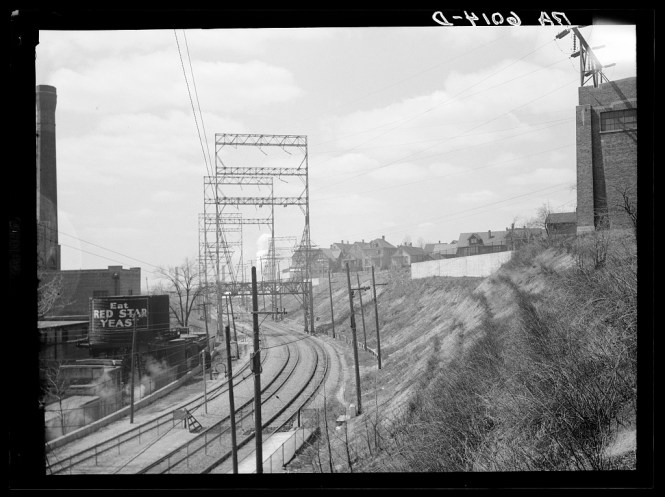
This 1939 view looks east on Congress from State St.. That’s Sears at left. The ‘L’ station in the foreground is the Old Congress St. stub terminal, and the Congress & Wabash ‘L’ station is directly behind it. After the Congress stub was no longer needed for rush-hour rapid transit service, the North Shore Line continued to use it as a baggage terminal. (Eric Bronsky Collection)
From guest contributor Eric Bronsky:
Sears has been in the news lately. The onetime catalog/mail order champion is fading fast. I was never a fan of Sears, but I was curious to see what this company has brought to the table over the years. One thing led to another and I ended up writing a piece about Sears’ State Street stores (that’s right, there were two Sears flagships in downtown Chicago). I illustrated it with my own photography plus some great historic images from my collection (including the monorail ride in Sears’ toy department).
The file ended up being too big to send as an email attachment, so I posted it online. To view, click on this link:
As a bonus, here are then-and-now photos of Congress Street.

Here’s the same view in November, 2015. During the 1950s, Congress St. was rebuilt into an artery feeding the Congress (now Eisenhower or I-290) Expressway. Street widening required cutting through Sears (and other buildings) to build arcaded sidewalks. The Congress & Wabash ‘L’ station was razed during the ’50s and the stub terminal followed in 1964. CTA Green and Orange Line trains currently run on the ‘L’ visible in the distance. The building which once housed Sears is now Robert Morris Center. CERA meetings are currently held in University Center, the building at right.
Several major department stores along State Street once had direct connections to ‘L’ stations on Wabash and subway stations along State. The first downtown Sears established a direct basement-level entrance to the Van Buren & Congress mezzanine of the Jackson & State station in 1943. When that store closed, this station entrance also closed. The basement arcade of the building at 22 W. Madison / 2 N. State (the Boston Store until 1948) had a subway entrance, but the new Sears store never used that entrance and it remained sealed. Macy’s (formerly Marshall Field’s) connection to the State St. subway is the last remaining department store entrance.
Of course, you are welcome to share this with others! You may also print out The Roebuck Stops Here or download it to save on your computer.
— Eric
Selected FSA/OWI Photos, 1935-45
The Library of Congress has uploaded a great many photos taken between 1935 and 1945 by the Farm Security Administration and the Office of War Information. You can search through their collections here.
We have selected some Chicago-area photos from this archive to share with you. These are mainly the ones that are, in some fashion, transportation related, although I have also included a few that aren’t. I hope that you will enjoy them.
There is not a lot of information provided with each photo, but our readers should be able to figure out most of the locations without too much difficulty. I think the picture showing sidewalks in an area where there aren’t any houses yet may be Westchester, where development started in the late 1920s and was delayed until after the end of World War II by the Great Depression.
The pictures of the “L” are from the south side. You should have no difficulty recognizing the Maxwell Street market, the Stockyards, etc. etc. The train station pictures are from Union Station. One photo shows the Illinois Central electric suburban commuter service, today’s Metra Electric.
I only found a few streetcar pictures in the archive. It may not be possible to determine where some were taken due to the fog.
-David Sadowski
Finally, here are a few from Milwaukee, circa WWII. I believe these may show the old Milwaukee Electric interurban right-of-way going west of the city, which was known as the “Rapid Transit” line. Portions of this are now taken up by an expressway.
Help Support The Trolley Dodger
This is our 121st post, and we are gradually creating a body of work and an online resource for the benefit of all railfans, everywhere. To date, we have received over 127,000 page views, for which we are very grateful.
You can help us continue our original transit research by checking out the fine products in our Online Store. You can make a donation there as well.
As we have said before, “If you buy here, we will be here.”
We thank you for your support.
New From Trolley Dodger Press:
American Streetcar R.P.O.s: 1893-1929
Mainline Railway Post Offices were in use in the United States from 1862 to 1978 (with the final year being operated by boat instead of on rails), but for a much briefer era, cable cars and streetcars were also used for mail handling in the following 15 cities*:
Baltimore
Boston
Brooklyn
Chicago
Cincinnati
Cleveland
New Bedford, Massachusetts
New York City
Philadelphia
Pittsburgh
Rochester, New York
St. Louis
San Francisco
Seattle
Washington, D.C.
*As noted by some of our readers, this list does not include interurban RPOs.
Our latest E-book American Streetcar R.P.O.s collects 12 books on this subject (over 1000 pages in all) onto a DVD data disc that can be read on any computer using Adobe Acrobat Reader, which is free software. All have been out of print for decades and are hard to find. In addition, there is an introductory essay by David Sadowski.
The rolling stock, routes, operations, and cancellation markings of the various American street railway post office systems are covered in detail. The era of the streetcar R.P.O. was relatively brief, covering 1893 to 1929, but it represented an improvement in mail handling over what came before, and it moved a lot of mail. In many places, it was possible to deposit a letter into a mail slot on a streetcar or cable car and have it delivered across town within a short number of hours.
These operations present a very interesting history, but are not well-known to railfans. We feel they deserve greater scrutiny, and therefore we are donating $1 from each sale of this item to the Mobile Post Office Society, in support of their efforts.
# of Discs – 1
Price: $19.95

















































Great collection of photos; brings back many good memories of riding the El, street cars, and boarding trains at Union Station.
Eric, Thank you for this wonderful write up on Sears!
I agree! Fantastic photos!
Thank you so much for sharing! Gotta love Sears Roebuck and everything Chicago about it but it was also Mr. Field that drove a lot of the transportation stops at 111 N. State.
8a33202v and 8a33205v are on Van Buren in front of LaSalle St. Station, looking west. I’ve seen 8a33205v in several other blogs, usually mis-identified. 8a33221v looks like the 2 ads seen in the lower right corner of 8a33205v. Too bad someone was walking in front of the North Shore ad.
8a32969v is looking north at the Van Buren IC Electric (now Metra Electric) station, still there today.
Thanks for the Sears presentation. I rode the monorail when I was 7 or 8 years old. The elevators were almost as big of a thrill ride – manually operated by elevator operators, no front door in the car, accelerated like a rocket.
Speaking of direct connections, of course there was the connection from the North Shore station on Wabash to NS’s section of the ‘L’ platform.
The one connection I used regularly (but never took a photo) was the one from LaSalle St. Station to the ‘L’ on VanBuren. It was spectacular by railfan standards: A large blue CRT era sign (“LaSalle St. Station – New York Central – Rock Island – Nickel Plate”) plus a blue neon “20th Century Limited” sign plus a yellow neon “Golden State” sign. Anyone know if these signs still exist? Anyone got any photos of them to share? Please?
Speaking of direct connectons, cont. –
I forgot to mention that the signs were on the south ‘L’ platform next to the LaSalle St. Station. The direct entrance to LaSalle St. Station was one level below. This arrangement allowed a shortcut from the street level up to the LaSalle St. Station track level without having to enter the ‘L’ station.
Yes, I remember this entrance, although I never used it since I didn’t take any of the trains at LaSalle St. station. They got rid of it in the early 1980s, I think.
Wonderful pix all around. The connection from the L to La Salle St Station is called out in an early Chicago map/Rock Island advert reprinted as retro wrapping paper.